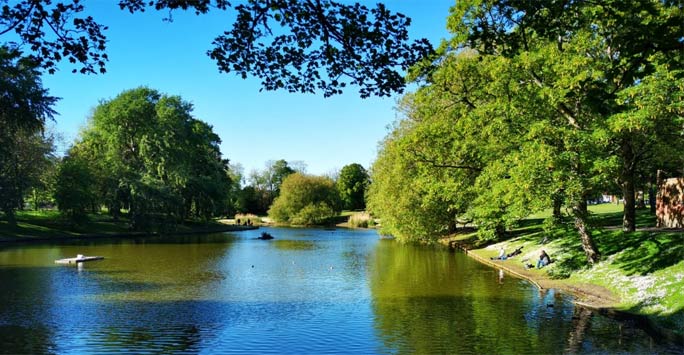
After feeling like we have been stuck inside for an eternity, students across Liverpool can slowly start to enjoy the beautiful locations in this historic city. Whilst Liverpool’s museums and indoor facilities are closed, take advantage of the sun and being allowed outdoors and explore some historic sites.
You can use this blog for inspiration for your next socially-distanced walk, or to think about destinations that you often visit in a new historic light.
Greenbank Park
A site well known to students residing at Smithdown or Greenbank Halls of Residence, Greenbank Park was formally owned by the Rathbone family. One notable family member was Eleanor Rathbone, a women’s right campaigner and Independent MP. As you walk you around the dominating pond feel energised by this remarkable woman, and perhaps research her fight for a Family Allowance and her Presidency of the National Union of Societies for Equal Citizenship. Furthermore, the Grade II listed Sefton Park Palm House is a 20-minute walk away from the park
Penny Lane
While you are in the Greenbank area, take a stroll down Greenbank Road and see the famed Penny Lane sign. Penny Lane was a populous meeting point for many Liverpudlians as they travelled to work or to the shops. It was also the bus stop that John Lennon, Paul McCartney and George Harrison spent many hours at. The area now has many thriving businesses near by and cafes to visit. During this surreal time, you can listen to the “kaleidoscopic” scene described in Penny Lane and romanticise this historic area of community. MacDonald, Ian (2005). Revolution in the Head: The Beatles' Records and the Sixties (2nd rev. ed.). London: Pimlico. 179
Albert Docks
Dating back nearly two centuries, the Royal Albert Docks’ architecture was radical and the docks undoubtedly shaped Liverpool. In the 21st Century, the complex is host to many cafes, restaurants, and museums. Once museums are reopened, the Interrnational Slavery Museum is very insightful and a must see, as well as the Tate Modern. With views to the waters and the Liver building and Beatle’s statue a short walk away, the docks can be used as a place for a walk or a place to sit, relax and contemplate with a beautifully made mocha.
The ‘Bombed-out Church’
The Church of Saint Luke was built in at the beginning of the 19th Century and was hit by an incendiary device during the ‘May Blitz’ in 1941. The fire left a skeleton version of the Church. Since then, the church has served as memorial to those who lost their lives in Liverpool during the Blitz. What I personally find fascinating is that the colloquial name, ‘The Bombed-Out Church’, speaks to the matter-of-fact nature of the city. The transformation of this space unites the history of the city with the present as it functions as a place for public art and event, reflecting the pattern of history that is woven into most places in Liverpool.
Connect with Liverpool's history
I hope this has given you some inspiration to see some historical sites that have been integrated and transformed into present day places of leisure. With the weather looking brighter and a need to embrace the outdoors, make your next outing more interesting by using some tips from this blog, or research further to properly connect with Liverpool’s history.
Sophia is an undergraduate student in the department of history.
Discover more
Find out more about studying history at Liverpool.